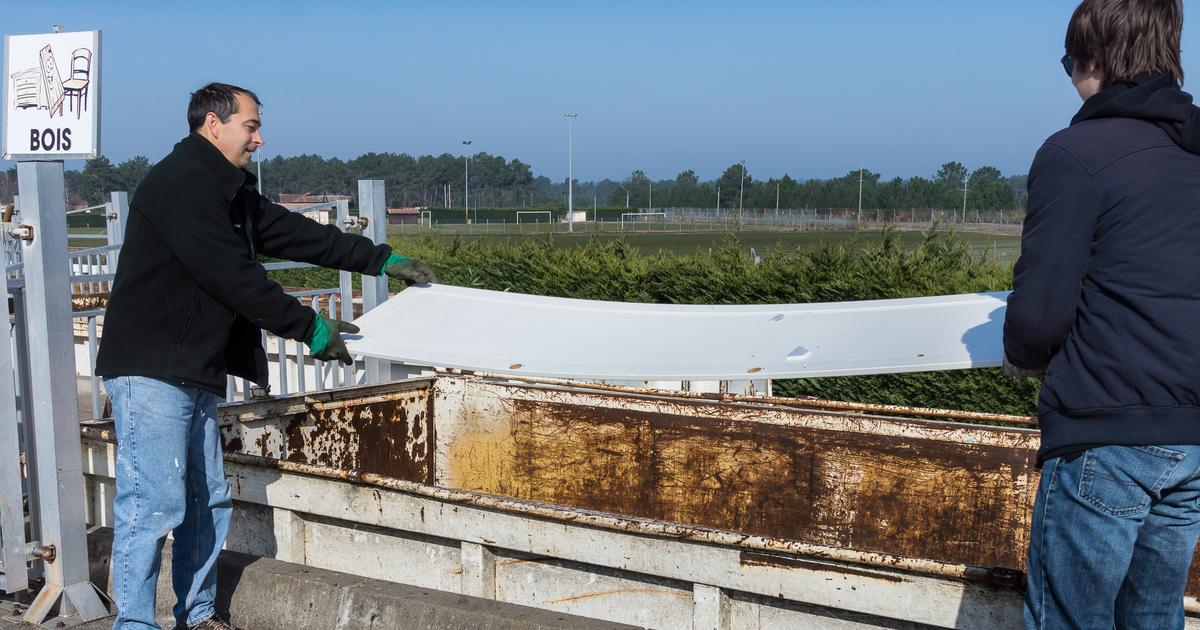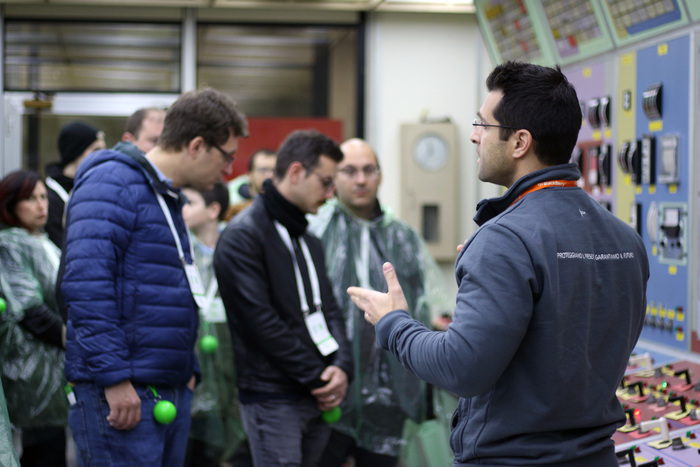Icon: enlarge
Scientists are looking for the best underground for the nuclear waste: The main factor here is how dense the host rock is.
Photo: AP / Sandia National Laboratories / Randy Montoya
It was a three year journey through the German underground.
Since 2017, 70 scientists from the Federal Association for Final Storage (BGE) have been collecting geological data on what it looks like beneath German soil - and where the highly radioactive nuclear waste from German nuclear power plants could most safely find its final resting place.
In order to pacify decades-long civil protests around the Gorleben nuclear waste storage facility, the authorities set the search for a repository to zero.
The researchers assumed a "white map" and treated all areas equally, it said.
That is why they had to scrutinize all of Germany: in search of a protected underground for a nuclear repository, the researchers contacted authorities in the most remote villages, in small towns and state capitals, from the Baltic Sea to the foothills of the Alps.
The "white map" has had its first patches of color since Monday morning: 90 areas in Germany are potentially suitable as locations for a nuclear repository.
This emerges from the interim report of the Federal Agency for Final Storage (BGE).
For the first time, the report names specific regions that are eligible for nuclear waste storage, most of which are in the north and south-east.
The controversial Gorleben salt dome, one of the first interim storage facilities in Germany, is out of the running.
"The Gorleben salt dome will therefore not be considered in the further work of the BGE on the proposals on the siting regions," says the report.
To compile this list, the researchers digitized yellowed maps, collected and analyzed over a million pieces of data - hard work.
The result was possible locations that were selected exclusively based on geological criteria.
It does not matter where these areas are, how many people live there or which government sits there in the state parliament.
Political claims such as those made by the Bavarian government, which has excluded a repository on its soil by coalition agreement, would not have played a role, according to the BGE.
"We all treated the same, including sites that were already contaminated like Gorleben," explains the CDU politician and managing director of the BGE, Steffen Kanitz.
Gorleben salt dome found to be "insufficient"
It is therefore surprising that Gorleben, as one of the best explored places in Germany, was dropped out very early in the selection process.
The search for a nuclear repository began in 1977 with the small town in Lower Saxony; geologists and politicians had found the site suitable for decades.
Only because of massive protests by local residents and the anti-nuclear movement was the commitment to Gorleben given up.
"Gorleben met all the minimum requirements, but was not sufficient in the geoscientific overall view," said BGE managing director Steffen Kanitz on Monday morning in Berlin.
This was mainly due to the "insufficient retention capacity" and the overburden, which was not completely intact.
According to the report, some of the salt dome is only covered with loose material, through which water could penetrate the host rock - i.e. the direct shell of the atomic deposit - over the years.
The location would also not have the backing for a million years of safe storage.
The good data situation for the formerly planned Gorleben site "must first be created for most of the other sub-areas," says hydrogeologist Traugott Scheytt from the TU Bergakademie Freiberg.
It is now urgent to check whether the reasons that led to the exclusion of Gorleben do not also apply to all other sub-areas of the host rock rock salt, according to the expert.
The list does not yet mark definitive locations for a repository, as Kanitz emphasizes, but rather "large-scale host rock configurations" - that is, suitable rock layers in the subsurface that can shield radioactive radiation from nuclear waste for as long as possible - in the best case up to a million years.
Despite all the effort, the list of areas is therefore no more than a fairly rough database with more or less large regions.
These have passed the first test and meet minimum requirements that the Bundestag laid down in the Site Selection Act in 2017.
How many suitable formations a federal state has is therefore not politically bad will, but simply the legacy of geological history.
Luck in misfortune: Germany has all three host rocks
Even the minimum requirements clearly limit the possibilities for a nuclear waste repository - but they are still so broad that more than half of the German territory made the list.
There are only three types of rock in the cavities of which the atomic barrels can be stored - the so-called host rocks: rock salt, mudstone and crystalline.
"In contrast to other countries, Germany has all three host rocks," says BGE managing director Kanitz, praising the German underground.
In addition, the surrounding rock must be at least 100 meters thick and at least 300 meters below the surface of the earth.
In addition, there are areas that, for understandable reasons, are out of the question: If there is a threat of plate tectonic shifts and earthquakes, the subsurface is in motion and, for example, rises over the centuries or there is volcanic activity in the area.
The BGE experts were able to completely exclude the Alps because the mountains can be shown to rise slowly.
The Rheingraben or the Swabian Alb also fell away because there are always smaller earthquakes.
According to BGE spokesman Kanitz, the host rocks, i.e. the immediate shell of the deposit, are treated equally by the geologists: "All three types of rock are safe".
Salt, clay and granite each have their advantages and disadvantages.
If there are many poor starting conditions in a host rock, it can also be completely unsuitable.
Salt rock
: withstands high temperatures, is very stable and has low permeability.
However, it is potentially water soluble.
Occurrence: Lower Saxony and Saxony-Anhalt
Mudstone
: is not very heat-resistant but has a low water solubility and high retention capacity.
Occurrence: Mecklenburg-Western Pomerania, Brandenburg, North Rhine-Westphalia and Baden-Württemberg
Granite
: is brittle, so water could penetrate it, but it has a high strength and low water solubility.
Occurrence: Saxony, Baden-Württemberg, Bavaria
All three types of rock are vulnerable to two factors: heat and water.
The nuclear waste is still warm for decades and heats up its surroundings.
There is also the risk that water will penetrate the host rock and distribute the nuclear particles into the environment.
What happens when a host rock is unsuitable is shown by the case of the Asse nuclear interim storage facility: water penetrating there has dissolved the salt rock and threatens to flush the nuclear waste out of the barrels.
Because most of the interim storage facilities in Germany are located in salt rock, it has been particularly well investigated.
What was surprising about the BGE report was that most of the "sub-areas" are clay formations.
They are mainly located in Lower Saxony, Schleswig-Holstein, Mecklenburg-Western Pomerania and also on the outskirts of Berlin and Brandenburg.
Researchers at the Federal Institute for Geosciences and Natural Resources (BGR) have been experimenting with clay rock since 1997.
In the Swiss "Mont Terri" test tunnel, they modeled, among other things, the diffusion of radioactive nuclides into the environment and the heat resistance of clay and the packaging material for nuclear waste.
The granite formations are more in the south of Germany - to the annoyance of Bavaria, which has already protested against the BGE report.
Plan for a million years
"The method of geological location selection is flawless," says hydrogeologist Traugott Scheytt.
He has already participated in the Japanese search for a nuclear repository and has been researching rock formations for water permeability for years.
"The problem lies less in the selection method than in the geological measurement uncertainties," says Scheytt.
Certain statements could be made for a maximum of a few thousand years.
After that, the predictions would be imprecise.
Water is a particularly great factor of uncertainty: it is in motion, changes its course and volume and is a link between the subsurface and the surface.
It is difficult to predict where the water veins will run in thousands of years and how quickly water will penetrate into the reservoir.
Example of determining water bodies: The Site Selection Act of 2017 stipulates that areas with "younger groundwater", i.e. relatively dynamic and unpredictable watercourses, must be excluded.
Hydrogeologists like Traugott Scheytt can measure how old a body of water is using the isotopes tritium and carbon-14.
But this is where the researchers come up against their limits: "The age of deeper waters is difficult to determine from an age of 5000 years", says Traugott Scheytt.
But the older a body of water is, the more certain it is that it does not penetrate into other rock layers.
In addition, there is not enough data for many areas.
Most of the regions published today have been poorly or not at all geologically investigated.
Here the researchers worked with 3-D models.
Soil analyzes should only be carried out in the second phase of the BGE investigations.
Despite the inaccuracies, researchers are pretty sure that there is such a thing as safe repository.
"Nature itself gives us an example that the long-term containment of radionuclides is possible," says Michael Kühn.
The hydrogeologist and geochemist works at the GFZ German Research Center for Geosciences in Potsdam and has no doubts that radioactive substances can really stay underground for a million years.
He refers to a uranium ore deposit in Gabon, West Africa, where spontaneous nuclear reactions took place 1.8 billion years ago like in a nuclear reactor.
The fission products remained trapped in the rock without any technical barriers, comparable to radioactive waste.
Two years ago, two US researchers began examining the natural nuclear reactor and taking samples.
"Switch from rejection to search"
The federal authority BGE now has ten years to find a suitable location.
In doing so, they sort out more and more areas over several steps until there is only one candidate in 2031.
Not every sub-area of the current BGE report can actually be considered as a location.
"In further steps, criteria beyond geology are also taken into account," explains Steffen Kanitz, managing director of BGE.
Icon: enlarge
The CDU politician Ernst Albrecht decided in 1977 to turn the Gorleben site into a nuclear waste storage facility.
The consequences were protests lasting for decades and a deep distrust of the population.
Photo: Wolfgang Weihs / dpa
In the next round, areas that are located in drinking water protection zones, near important cultural assets or under densely populated cities are eliminated first.
The Site Selection Act of 2017 already states that a distance to buildings of less than 500 meters is "less favorable", whereas a distance of one kilometer is "favorable".
But also floodplain areas or areas in which mineral resources are extracted, such as coal or oil through fracking, are very likely to disappear as locations.
"Due to the negative experiences with amateurishly selected and treated nuclear waste dumps such as Asse or Morsleben, there is an abysmal distrust of selection processes in many initiatives and in the public, and the firm belief that there can be no safe final repository", comments environmental researcher Rainer Grießhammer .
He is a member of the national support committee for the search for a repository, which is supposed to ensure a democratic search for a location and for acceptance among the population.
"Nevertheless, we have to switch from rejection to search. We cannot live with unsafe interim storage facilities in the long term, and we also do not want to export to Siberian permafrost."
Icon: The mirror















